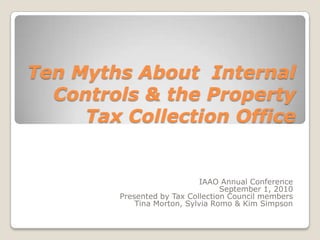The ten myths about internal controls & the
•Descargar como PPTX, PDF•
0 recomendaciones•363 vistas
Denunciar
Compartir
Denunciar
Compartir

Recomendados
Recomendados
2014-06-11 Nonprofit Fraud - What You Need to Know Part III - The Prevention

2014-06-11 Nonprofit Fraud - What You Need to Know Part III - The PreventionRaffa Learning Community
Más contenido relacionado
Similar a The ten myths about internal controls & the
2014-06-11 Nonprofit Fraud - What You Need to Know Part III - The Prevention

2014-06-11 Nonprofit Fraud - What You Need to Know Part III - The PreventionRaffa Learning Community
Similar a The ten myths about internal controls & the (20)
Behavioural Economics & Financial Services: Improving Customer Outcomes

Behavioural Economics & Financial Services: Improving Customer Outcomes
Keys to the Successful Development and Implementation of a CIT Program 

Keys to the Successful Development and Implementation of a CIT Program
The final deliverable for the Course Project is a narrated prese.docx

The final deliverable for the Course Project is a narrated prese.docx
Thought Leadership on Ethics & Compliance scale Final

Thought Leadership on Ethics & Compliance scale Final
2014-06-11 Nonprofit Fraud - What You Need to Know Part III - The Prevention

2014-06-11 Nonprofit Fraud - What You Need to Know Part III - The Prevention
Joseph Sheffu - Ethics and Governance for Professionals.pptx

Joseph Sheffu - Ethics and Governance for Professionals.pptx
Top Strategies for Encouraging Employees to Use Your Whistleblower Hotline

Top Strategies for Encouraging Employees to Use Your Whistleblower Hotline
Management training assignment 3 advanced accounting bayo cary

Management training assignment 3 advanced accounting bayo cary
Deloitte Dbriefs Program Guide | April - June 2014

Deloitte Dbriefs Program Guide | April - June 2014
The ten myths about internal controls & the
- 1. Ten Myths About Internal Controls & the Property Tax Collection Office IAAO Annual Conference September 1, 2010 Presented by Tax Collection Council members Tina Morton, Sylvia Romo & Kim Simpson
- 2. Myth #1: few care about internal controls Definition Audit, auditors and their roles Does the public care? Why everyone in the office should care
- 3. Myth #2: Internal Controls are the same in all offices Offices vary with responsibilities Effect of operations other than tax collection Size, location and use of technology
- 4. Myth #3: Audits always find weakneses in internal controls Define audit and types of audit Internal audit a performance evaluation tool Audit covers specifics – may not address human factors
- 5. Myth #4: Collection offices are not impacted by others’ criminal acts Discuss concept of public trust and how it has eroded with private / public failures Define voluntary compliance Relate voluntary compliance to public trust – what does having it mean for our collection rates? Perception of wrong-doing If there is a problem, is it better to expose or hide?
- 6. Myth #5: Ethical behavior among employees varies little Define ethics Value of written ethical conduct policy Ethical decision making has changed completely over the last 3 decades
- 7. Myth #6: Employees do not need to understand internal controls Critical need to understand internal controls and therefore, performance expectations Sustainable training program needed Personal accountability for funds
- 8. Myth #7: Specific internal controls, such as a cash handling policy, should be updated before the annual audit Policy for the auditor only misses the point Dynamic nature of efficient / effective policies and systems Sometimes a policy needs an overhaul
- 9. Myth #8: Theft & fraud are unpredictable Good internal controls provide means to address theft & fraud Reporting responsibilities Clarify criminal penalties
- 10. Myth #9: Internal controls should not be made public Transparency What are limits to transparency if any? Educating the public may lead to better understanding / acceptance of unpopular policies, like NSF fees
- 11. Myth #10: With adequate policies in place, internal control problems can be EASILY identified & resolved. It’s never easy Establish & maintain climate of shared responsibility Recognize & reward behavior that helps to standardize desired ethical conduct Promote communication about policy & encourage input for improvement